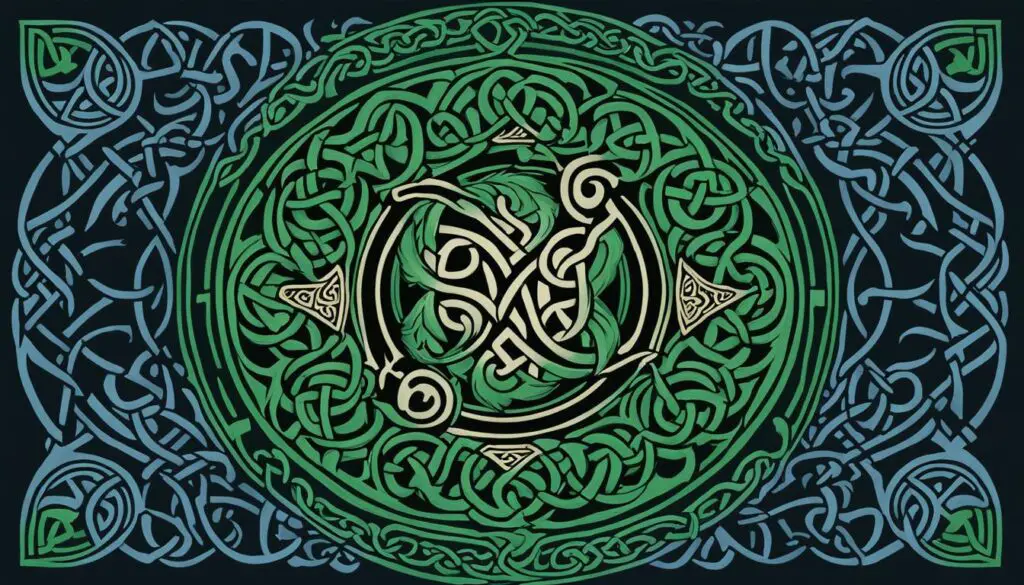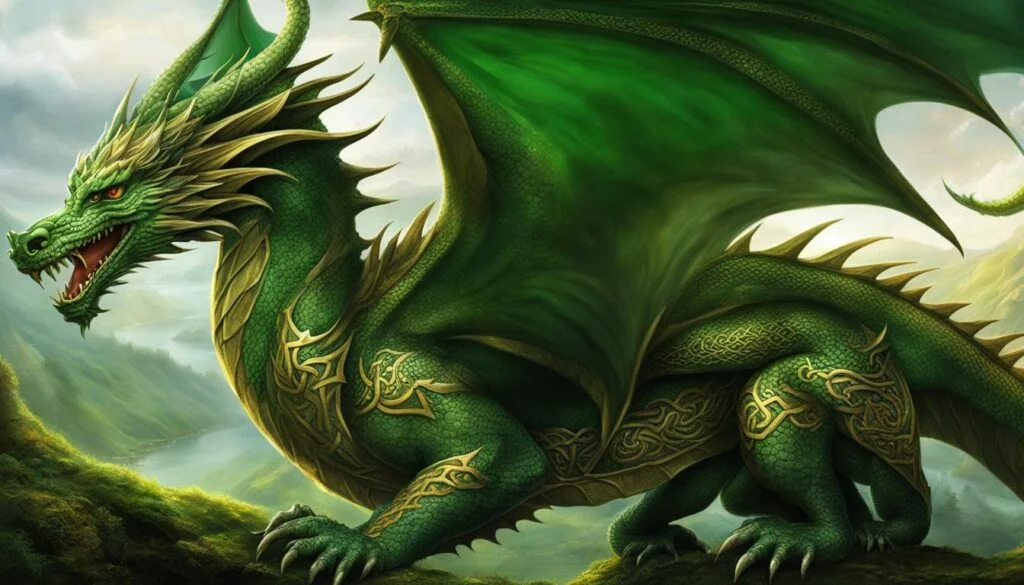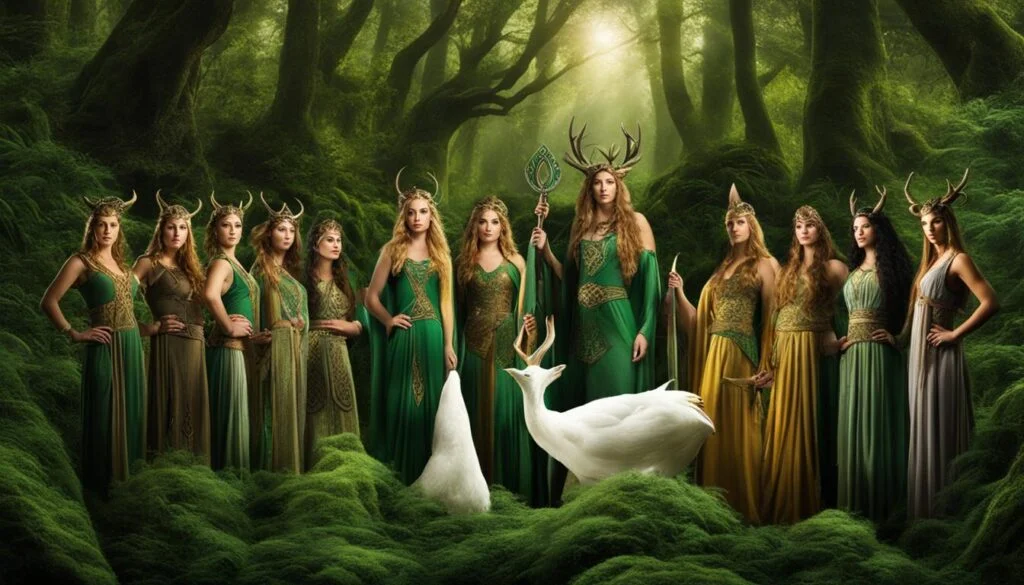Celtic mythology is a fascinating world of ancient legends and folklore that finds its roots in several countries. The enchanting stories and deities of Celtic mythology have been shaped and preserved by nations such as Wales, Ireland, Scotland, and Brittany. Together, these countries have created a rich cultural heritage filled with tales of gods, heroes, and mythical creatures.
Key Takeaways:
- Celtic mythology originated from countries including Wales, Ireland, Scotland, and Brittany
- Each country has its own unique contribution to Celtic mythology and folklore
- Welsh mythology features mythical creatures and the legendary figure of King Arthur
- Irish mythology is known for its captivating tales of gods, heroes, and mystical creatures
- Scottish mythology reflects the rich cultural heritage of the Scottish people and includes beings like selkies and the Loch Ness Monster
- The Bretons of Brittany have preserved their unique folklore and traditions, adding to the tapestry of Celtic mythology
The Influence of Wales in Celtic Mythology
Welsh mythology holds a significant place in the tapestry of Celtic folklore. This enchanting tradition is filled with captivating tales of gods and goddesses, mythical creatures, and legendary figures.
One of the most prominent elements of Welsh mythology is the presence of dragons. These majestic creatures symbolize power and wisdom, and their legends are deeply intertwined with the culture of Wales. The Welsh dragon, often depicted as a red dragon, holds a special place in the hearts of Welsh people and is a symbol of their national identity.
The Legendary King Arthur
Another iconic figure in Welsh mythology is King Arthur. Known as the legendary king who led the defense against the Saxon invaders, King Arthur’s stories are filled with magic, bravery, and the pursuit of justice. His tales continue to inspire and captivate audiences around the world.
The Mabinogion, a collection of Welsh folklore and mythology, is a treasure trove of stories and legends. These tales provide insights into the ancient beliefs, traditions, and wisdom of the Welsh people. From the mischievous adventures of the trickster god Lleu Llaw Gyffes to the tragic love story of Branwen and Matholwch, the Mabinogion is a testament to the rich cultural heritage of Wales.
Welsh mythology, with its fascinating deities, magical creatures, and heroic figures, adds a unique and captivating dimension to the broader tapestry of Celtic mythology. The influence of Wales can be seen in the shared themes and motifs across Celtic folklore.
- Welsh mythology embraces a pantheon of gods and goddesses, each with distinct attributes and roles.
- Dragons, symbolizing power and wisdom, are an integral part of Welsh mythology.
- King Arthur, the legendary figure, is deeply rooted in Welsh mythology and folklore.
- The Mabinogion, a collection of Welsh mythology, offers valuable insights into the rich cultural heritage of Wales.
As we continue our exploration of Celtic mythology, let us now turn our attention to the captivating realm of Irish mythology, where gods, heroes, and magical creatures await.
The Rich Tradition of Irish Mythology
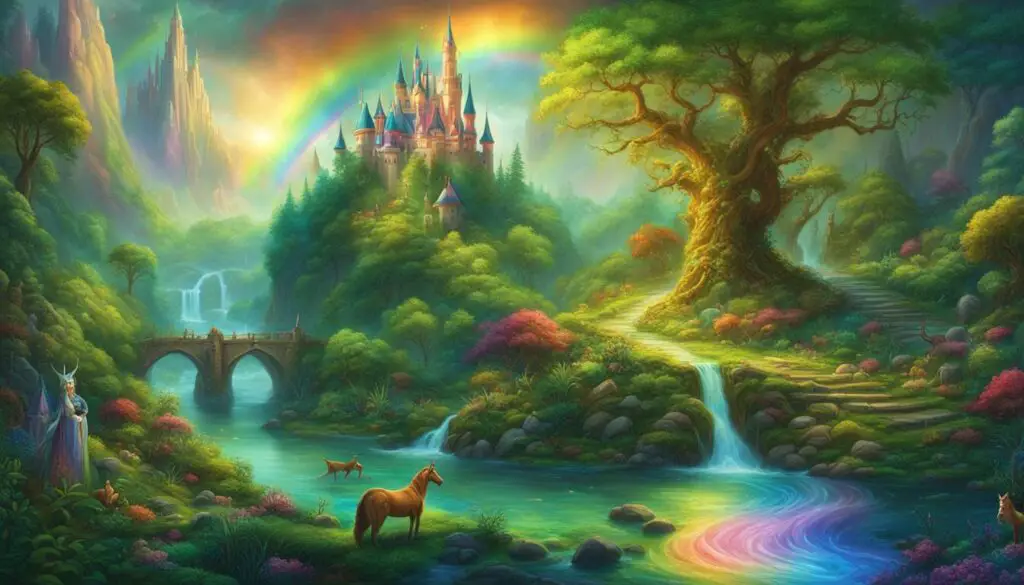
Ireland boasts a rich tradition of mythology that captivates with its mesmerizing tales of gods and goddesses, heroes and heroines, and enchanting creatures. The realm of Irish mythology is a tapestry woven with stories filled with magic and wonder, passed down through generations.
Within Irish mythology, one encounters a vast array of divine beings, each possessing their own unique powers and significance. One such prominent figure is the Morrigan, the goddess of war and sovereignty. Known for her formidable presence and shape-shifting abilities, the Morrigan embodies the complexity and strength that lies at the heart of Irish mythology.
Another legendary character that looms large in Irish mythology is Cu Chulainn, a heroic warrior whose deeds are the stuff of legend. With his fierce battle prowess and unwavering loyalty, Cu Chulainn embodies the spirit of heroism and resilience that defines the tales of Irish mythology.
But it is not only the gods and heroes that populate Irish mythology. Mystical creatures like leprechauns, mischievous and elusive, and banshees, harbingers of death and sorrow, add an air of enchantment and mystery to the stories. They bring forth a sense of the otherworldly, the magical, and the unknown.
It is through the tales of Irish mythology that one can glimpse the profound connection between the Irish people and their ancient heritage. These stories continue to be passed on, cherished, and celebrated, not only in Ireland but also among people around the world who find themselves drawn to the allure of Celtic folklore and the age-old tales of gods and goddesses that have shaped Irish culture.
Unveiling the Secrets of Scottish Mythology
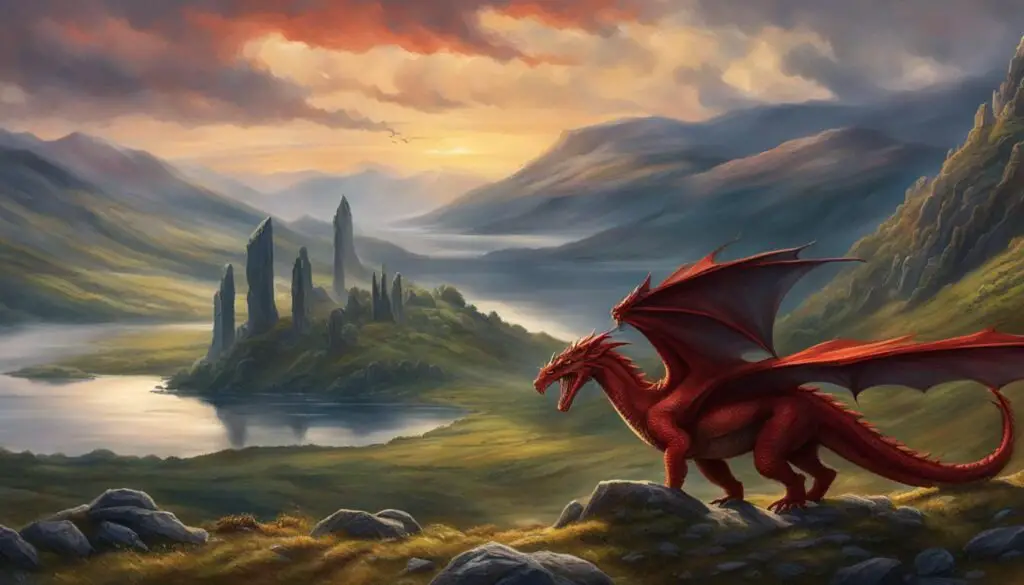
Scotland has its own unique contribution to Celtic mythology, with a rich tapestry of folklore and legends. Scottish mythology is deeply intertwined with the ancient Picts, an early Celtic people who inhabited the region. These myths and stories have been passed down through generations, reflecting the rich cultural heritage of the Scottish people.
One intriguing aspect of Scottish mythology is the presence of mythical beings like selkies and kelpies. Selkies are said to be shape-shifting creatures, often depicted as seals who can transform into humans. These enchanting beings are known for their mesmerizing singing voices and captivating stories of lost love. On the other hand, kelpies are horse-like water spirits that lure unsuspecting travelers to their watery demise. These tales serve as cautionary reminders of the dangerous power of Scotland’s natural landscapes.
Of course, no discussion of Scottish mythology would be complete without mentioning the iconic figure of the Loch Ness Monster. According to legend, this elusive creature resides in the depths of Loch Ness, captivating the imaginations of locals and visitors alike. While some skepticism surrounds the existence of the Loch Ness Monster, its enigmatic nature continues to fuel the fascination with Scottish mythology.
The traditions and stories of Scottish mythology have ingrained themselves deeply into the fabric of Scottish society. Festivals such as the Beltane and Samhain celebrate ancient rituals and customs, keeping the spirit of Celtic myth alive. Moreover, Scottish folklore has even inspired contemporary literature, films, and artwork, further perpetuating its enduring influence.
Explore the enchanting realm of Scottish mythology and immerse yourself in the captivating folklore of this fascinating Celtic nation. From mythical creatures to age-old legends, Scottish mythology offers a glimpse into a world steeped in magic and wonder.
The Influence of Brittany in Celtic Mythology
Brittany, located in northwestern France, is a region that significantly contributes to the rich tapestry of Celtic mythology. The Bretons, who have Celtic roots, have preserved their unique folklore and traditions, adding depth to the vibrant world of ancient legends. Through their tales, Brittany offers valuable insights into the fascinating cultural heritage of the Celtic nations.
The legends of Brittany revolve around mythical beings and ancient deities, intertwining seamlessly with the broader Celtic mythology. These stories serve as a testament to the Breton people’s commitment to preserving their heritage, ensuring that the tales of Celtic gods and goddesses continue to captivate generations.
Brittany’s folklore is a treasure trove of enchanting and mysterious narratives that showcase the region’s rich historical connection to the Celtic nations. The myths and legends passed down through generations illuminate the beliefs, customs, and imagination of the Bretons, keeping Celtic folklore alive for all to discover.
FAQ
What are the key countries in Celtic mythology?
The main contributing countries to Celtic mythology include Wales, Ireland, Scotland, and Brittany.
What is the influence of Wales in Celtic mythology?
Wales has a significant role in Celtic mythology, with its own unique pantheon of gods and goddesses. Welsh mythology is known for its tales of mythical creatures like dragons and the legendary figure of King Arthur.
What is the rich tradition of Irish mythology?
Ireland is renowned for its rich tradition of mythology, filled with captivating tales of gods and goddesses, heroes and heroines, and mystical creatures like leprechauns and banshees. The stories of Irish mythology continue to enchant and inspire both locals and people around the world.
What are the secrets of Scottish mythology?
Scotland has its own unique contribution to Celtic mythology, with a rich tapestry of folklore and legends. Scottish mythology is known for its connection to the ancient Picts and features mythical beings like selkies and kelpies. The stories and traditions of Scottish mythology reflect the rich cultural heritage of the Scottish people.
How did Brittany influence Celtic mythology?
Brittany, a region in northwestern France, is another significant contributor to Celtic mythology. The Bretons, who have Celtic roots, have preserved their unique folklore and traditions, including tales of mythical beings and ancient deities. The legends of Brittany are closely intertwined with Celtic mythology and provide valuable insights into the cultural heritage of the region.


